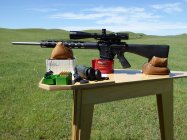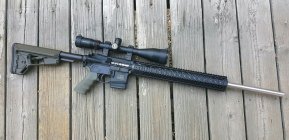TheCZKid
Silver $$ Contributor
I'm just getting back to working on loads for my 20 Practical, since 2018. I was reviewing my process of making 20P brass from Lake City cases. Today I was sizing my cases in stages, and noticed the concentricity was good from first FL die, then went way off with first bushing. So I called Redding today to see if I was doing something wrong. They said if I'm getting 5 thousandths of runout that's really good, and should not have any noticeable affect on accuracy.
Some cases were going from about 1 thousandth to 5 to 8 thousandths. Tonight I found a method for making my cases average 2 thousandths of concentricity when final. So, I wrote myself a "how to" page, so I could review it in the future, if I forgot again.
I'm not sure how well others first converted cases are turning out, and am curious if my methods are similar to others. Here's my info I wrote, curious what you think of my "How-To Tutorial" list for myself. Thought it might be helpful for new 20 Practical reloaders too.
How to make Concentric 20 P Cases, with your first conversion cases.
Prepare cases by de-capping the primers, cleaning the cases, primer pocked uniforming, and flash-hole deburring.
1. First size once shot cases in a Full-Length Small Base sizing die, with the Expander Rod removed.
2. With my RCBS FL SB die it takes the neck diameter from outside diameter of .2520” to .2375”, and I only let the shoulder get pushed back to 1.575” or less approximately, not below 1.573” base to shoulder datum, with Hornady G240 case comparator. The concentricity from a Full Length die should be about 1 thousandth.
3. Next, with Redding S Die put in 233 bushing with the lock-nut from the expander rod on top as a spacer. Set die to NOT “bump” or set back the shoulder for this first bushing sizing, or at least not to the final shoulder bump you want for the final dimension. The concentricity might not be very good, from .002” to .008” runout.
4. In Redding die, install 225 or desired final bushing size stamping facing down, and then set the die to bump the shoulder back to 1.567” base to shoulder with AR barrel (or to your desired final dimension for your chamber). With the bushing and the bump together in the final sizing, this should bring the concentricity to .001 to .004 on average. The shoulder bump and bushing sizing both together on final sizing seems to really help to bring the neck into concentricity with the case on the final sizing. I even had the .008 runout necks go back to about .002 to .004 using this method.
5. After it’s sized, then trim necks to OAL of 1.750" or 1.755” for case, and chamfer & deburr the necks. Clean sizing lube off exterior, run a brush through the necks, and you’re ready to load.
Annealing might be a good idea after your cases are freshly converted, or at least after fired 2 or 3 times.
Neck Turning:
After the brass is shot and fire-formed to your chamber, it will be more concentric. This would be a good time to turn the necks. The sizing down of the neck from 223 to 20P tends to make the final thickness of the neck uneven, and a skim turn to bring it to uniform thickness will help in accuracy.
Keep in mind, if you turn the necks, it will make change the outside diameter of the neck, and lessen how much your bushing ends up sizing your necks, and neck tension will be less. If you use a bolt action rifle the neck tension can be as low as one to two thousandths. If you are using an AR upper you will need more neck tension to keep the bullets from sliding forward when they chamber, so you might need a smaller bushing. In an AR four thousandths or more neck tension might be minimal to be safe. So, a final bushing might be 224, or what you determine is correct for your application.
Some cases were going from about 1 thousandth to 5 to 8 thousandths. Tonight I found a method for making my cases average 2 thousandths of concentricity when final. So, I wrote myself a "how to" page, so I could review it in the future, if I forgot again.
I'm not sure how well others first converted cases are turning out, and am curious if my methods are similar to others. Here's my info I wrote, curious what you think of my "How-To Tutorial" list for myself. Thought it might be helpful for new 20 Practical reloaders too.
How to make Concentric 20 P Cases, with your first conversion cases.
Prepare cases by de-capping the primers, cleaning the cases, primer pocked uniforming, and flash-hole deburring.
1. First size once shot cases in a Full-Length Small Base sizing die, with the Expander Rod removed.
2. With my RCBS FL SB die it takes the neck diameter from outside diameter of .2520” to .2375”, and I only let the shoulder get pushed back to 1.575” or less approximately, not below 1.573” base to shoulder datum, with Hornady G240 case comparator. The concentricity from a Full Length die should be about 1 thousandth.
3. Next, with Redding S Die put in 233 bushing with the lock-nut from the expander rod on top as a spacer. Set die to NOT “bump” or set back the shoulder for this first bushing sizing, or at least not to the final shoulder bump you want for the final dimension. The concentricity might not be very good, from .002” to .008” runout.
4. In Redding die, install 225 or desired final bushing size stamping facing down, and then set the die to bump the shoulder back to 1.567” base to shoulder with AR barrel (or to your desired final dimension for your chamber). With the bushing and the bump together in the final sizing, this should bring the concentricity to .001 to .004 on average. The shoulder bump and bushing sizing both together on final sizing seems to really help to bring the neck into concentricity with the case on the final sizing. I even had the .008 runout necks go back to about .002 to .004 using this method.
5. After it’s sized, then trim necks to OAL of 1.750" or 1.755” for case, and chamfer & deburr the necks. Clean sizing lube off exterior, run a brush through the necks, and you’re ready to load.
Annealing might be a good idea after your cases are freshly converted, or at least after fired 2 or 3 times.
Neck Turning:
After the brass is shot and fire-formed to your chamber, it will be more concentric. This would be a good time to turn the necks. The sizing down of the neck from 223 to 20P tends to make the final thickness of the neck uneven, and a skim turn to bring it to uniform thickness will help in accuracy.
Keep in mind, if you turn the necks, it will make change the outside diameter of the neck, and lessen how much your bushing ends up sizing your necks, and neck tension will be less. If you use a bolt action rifle the neck tension can be as low as one to two thousandths. If you are using an AR upper you will need more neck tension to keep the bullets from sliding forward when they chamber, so you might need a smaller bushing. In an AR four thousandths or more neck tension might be minimal to be safe. So, a final bushing might be 224, or what you determine is correct for your application.
Last edited:













